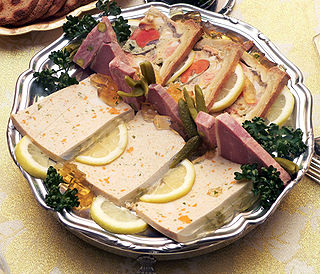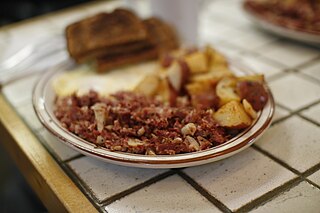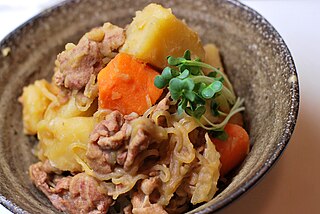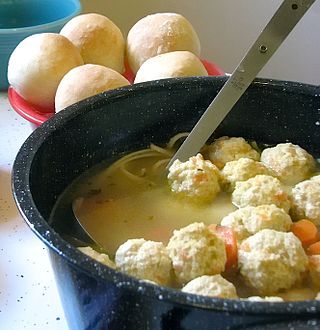
Haggis is a savoury pudding containing sheep's pluck, minced with chopped onion, oatmeal, suet, spices, and salt, mixed with stock, and cooked while traditionally encased in the animal's stomach though now an artificial casing is often used instead. According to the 2001 English edition of the Larousse Gastronomique: "Although its description is not immediately appealing, haggis has an excellent nutty texture and delicious savoury flavour".
Gravy is a sauce made from the juices of meats and vegetables that run naturally during cooking and often thickened with thickeners for added texture. The gravy may be further coloured and flavoured with gravy salt or gravy browning or bouillon cubes. Powders can be used as a substitute for natural meat or vegetable extracts. Canned and instant gravies are also available. Gravy is commonly served with roasts, meatloaf, rice, noodles, fries (chips), mashed potatoes, or biscuits.

Tripe is a type of edible lining from the stomachs of various farm animals. Most tripe is from cattle and sheep.

Lancashire hotpot is a stew originating in Lancashire in the North West of England. It consists of lamb or mutton and onion, topped with sliced potatoes and slowly baked in a pot at a low heat.

Offal, also called variety meats, pluck or organ meats, is the internal organs of a butchered animal. The word does not refer to a particular list of edible organs, and these lists of organs vary with culture and region, but usually exclude skeletal muscle. Offal may also refer to the by-products of milled grains, such as corn or wheat.

Meatloaf is a dish of ground meat that has been combined with other ingredients and formed into the shape of a loaf, then baked or smoked. The final shape is either hand-formed on a baking tray, or pan-formed by cooking it in a loaf pan. It is usually made with ground beef, although ground lamb, pork, veal, venison, poultry, and seafood are also used, sometimes in combination. Vegetarian adaptations of meatloaf may use imitation meat or pulses.

Hash is a dish consisting of chopped meat, potatoes, and fried onions. The name is allegedly derived from French: hacher, meaning 'to chop'. It originated as a way to use up leftovers. In the U.S. by the 1860s, a cheap restaurant was called a "hash house" or "hashery."

Moussaka is an eggplant (aubergine)- or potato-based dish, often including ground meat, which is common in the Balkans and the Middle East, with many local and regional variations.

Cawl is a Welsh dish. In modern Welsh, the word is used for any soup or broth; in English, it refers to a traditional Welsh soup, usually called cawl Cymreig in Welsh. Historically, ingredients tended to vary, but the most common recipes are lamb or beef with leeks, potatoes, swedes, carrots and other seasonal vegetables. Cawl is recognised as a national dish of Wales.

Stovies is a Scottish dish based on potatoes. Recipes and ingredients vary widely but the dish contains potatoes, fat, usually onions and often pieces of meat. In some versions, other vegetables may be added.

Nikujaga is a Japanese dish of meat, potatoes, and onions stewed in dashi, soy sauce, mirin, and sugar, sometimes with ito konnyaku and vegetables like carrots. Nikujaga is a kind of nimono. It is usually boiled until most of the liquid has been reduced. Thinly sliced beef is the most common meat used, although minced or ground beef is also popular. Pork is often used instead of beef in eastern Japan.

Rinderrouladen are a German meat dish, usually consisting of bacon, onions, mustard and pickles wrapped in thinly sliced beef which is then cooked. The dish is considered traditional also in the Upper Silesia region of Poland where it is known as rolada śląska and in the Czech Republic where it is known as španělský ptáček. In Britain, the equivalent dish is widely referred to as beef olives.

Scottish cuisine encompasses the cooking styles, traditions and recipes associated with Scotland. It has distinctive attributes and recipes of its own, but also shares much with other British and wider European cuisine as a result of local, regional, and continental influences — both ancient and modern.
A collop is a slice of meat, according to one definition in the Oxford English Dictionary. In Elizabethan times, "collops" came to refer specifically to slices of bacon. Shrove Monday, also known as Collop Monday, was traditionally the last day to cook and eat meat before Ash Wednesday, which was a non-meat day in the pre-Lenten season also known as Shrovetide. A traditional breakfast dish was collops of bacon topped with a fried egg.

Clapshot is a traditional Scottish dish that originated in Orkney and may be served with haggis, oatcakes, mince, sausages or cold meat. It is created by the combined mashing of swede turnips and potatoes with the addition of chives, butter or dripping, salt and pepper; some versions include onions. The name is Orcadian in origin.

A meatball is ground meat (mince) rolled into a ball, sometimes along with other ingredients, such as bread crumbs, minced onion, eggs, butter, and seasoning. Meatballs are cooked by frying, baking, steaming, or braising in sauce. There are many types of meatballs using different types of meats and spices. The term is sometimes extended to meatless versions based on legumes, vegetables, mushrooms, fish or other seafood.

Olivier salad is a traditional salad dish of Russian cuisine. Its creation is generally attributed to Lucien Olivier.

Keema matar, also rendered Qeema matar, is a dish from the Indian subcontinent associated with the Mughals. The term is derived from Chaghatai Turkic قیمه which is cognate with Turkish kıyma.
















